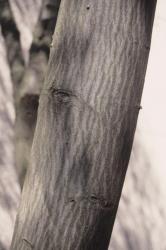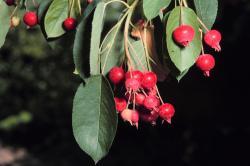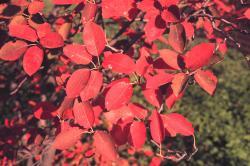June 27, 2013
| Amelanchier spp. Serviceberry
|
| Description | Serviceberry offers multi-seasonal interest from showy spring flowers to the bird show as fruit is ripening then to the fall colour as leaves finish off their year. Add tolerance to most growing conditions and few pests and you have a very versatile small tree. |
| Usage | Container, specimen, street tree. |
| Origin | Across Canada, 5-6 species |
| Hardiness zone | 4 |
| Size | 9m |
| Form/texture | Rounded, upright vase; small single trunked tree or multi-stemmed large shrub. Medium texture foliage casts a light shade. |
| Growth rate | Moderate; moderate life span. |
| Leaf | Alternate, simple, turning glorious shades of gold, orange and red in autumn. |
| Flower | May; hot spring days hasten senescence. |
| Fruit | Berry-like pome, delicious to birds, animals and man. "While the fruits of A. arborea are inedible, to all bipeds but birds, those of this slender little tree (A. laevis) are pleasant enough to find favor sometimes with ever-hungry country youngsters" (Peattie). |
| Exposure/culture | Tolerates part shade to full sun; naturally found as understory plant, at the edge of woodlands, open fields and fencerows. Tolerant of occasional periods of drought. Moderately sensitive to salt (Beckerman et al) Easily transplanted. Prone to same pests, diseases that attack all rose family members, but seldom seriously affected. |
| Comments | It is spring at last in the woods when the Amelanchier flower. "The bark is smooth, gray, conspicuously marked by a slightly twisted network of darker vertical lines" (Farrar). The twigs, buds and fruit are an important food source for many animals. Amelanchier can be a confusing genus with several species, hybrids and cultivars available in the trade, many of which are distributed with conflicting nomenclature. "When you venture into the botanical maze searching for the specific identity of a serviceberry, you may never return. Taxonomists themselves .... do not agree on the division of the Amelanchier genus into species" (Blouin). The most commonly available tree-sized Amelanchier species are downy serviceberry, Amelanchier arborea, and the Allegheny serviceberry, Amelanchier laevis. They are very similar in size and appearance and both make lovely, small, early spring-blooming trees for sites that aren't too harsh. Amelanchier xgrandiflora is a hybrid between these species with many more profusely blooming cultivars. Shadblow serviceberry, Amelanchier canadensis is a multi-stemmed shrub. These trees are a wonderful native choice for urban sites where the native soils haven't been stripped and compaction and road salt isn't too heavy. Named cultivars are improving on heat and drought tolerance with choices in height and fall colour. Henry Gerhold conducted a street tree trial that examined the performance of various cultivars (Gerhold).
|




Reference:
Beckerman, J. and B.R. Lerner. 2009. Salt Damage in Landscape Plants. Purdue Extension Publication ID-412-W. Purdue University. West LaFayette, IN.
Blouin, G. 2001. An Eclectic Guide to Trees East of the Rockies. Boston Mill Press. Erin, ON.
Farrar, J.L. 1995. Trees in Canada. Fitzhenry and Whiteside Limited, Markham, Ontario and Canadian Forest Service, Natural Resources Canada, Ottawa.
Gerhold, H. D. 2008. Serviceberry Cultivars tested as Street Trees: Second Report. Arboriculture and Urban Forestry 34(2): 129-132.
Peattie, D.C. 1964. A Natural History of Trees of Eastern and Central North America. 2nd ed. Bonanza Books. New York, NY. 606pp.